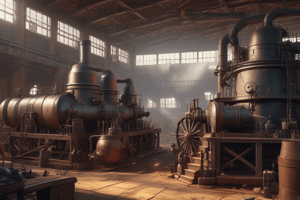Podcast
Questions and Answers
What role did railroads play in America's industrial success?
What role did railroads play in America's industrial success?
- Advocating for better working conditions and economic equality
- Facilitating commerce and introducing time zones (correct)
- Lowering prices and improving living standards for workers
- Creating national brands and pioneering modern organizational methods
What impact did industrial competition have on American workers in the late 19th century?
What impact did industrial competition have on American workers in the late 19th century?
- Increasing benefits and shortening working hours
- Creating a rise in unions and better working conditions
- Leading to job insecurity and economic fluctuations
- Lowering prices and improving living standards (correct)
Which union was the first national union but declined after the Haymarket riot in 1886?
Which union was the first national union but declined after the Haymarket riot in 1886?
- Teamsters Union
- American Federation of Labor (AFL)
- United Auto Workers (UAW)
- Knights of Labor (correct)
What flawed interpretation of Darwin's theory justified corporate power and wealth inequality?
What flawed interpretation of Darwin's theory justified corporate power and wealth inequality?
Which labor union gained traction by focusing on practical labor issues and had around 250,000 members by 1892?
Which labor union gained traction by focusing on practical labor issues and had around 250,000 members by 1892?
What impacts led to depressions in the 1870s and 1890s, affecting the working poor the most?
What impacts led to depressions in the 1870s and 1890s, affecting the working poor the most?
What played a crucial role in improving the finance system and boosting industrialization in the United States after the Civil War?
What played a crucial role in improving the finance system and boosting industrialization in the United States after the Civil War?
What factor contributed to the transformation of the U.S. from an agrarian society to an industrial urban one?
What factor contributed to the transformation of the U.S. from an agrarian society to an industrial urban one?
What constitutional element established the U.S. as a single area of commerce, contributing to economic growth?
What constitutional element established the U.S. as a single area of commerce, contributing to economic growth?
What factor attracted capital from Europe to invest in America's economic development?
What factor attracted capital from Europe to invest in America's economic development?
By what year did a majority of the U.S. workforce engage in non-farming jobs?
By what year did a majority of the U.S. workforce engage in non-farming jobs?
What proportion of the world's industrial output was produced by the U.S. by 1913?
What proportion of the world's industrial output was produced by the U.S. by 1913?
Flashcards are hidden until you start studying
Study Notes
- The United States experienced significant industrial growth in the decades following the Civil War, transitioning from a country with one-third of Great Britain's industrial output to becoming the wealthiest and most industrialized nation globally.
- The Civil War played a crucial role in improving the finance system, introducing a national currency, and boosting industrialization through massive contracts to arms and clothing manufacturers.
- Geographically, the U.S. had abundant resources like coal, iron, and later oil, along with a growing population due to immigration, transforming from an agrarian society to an industrial urban one.
- The American Constitution, with its commerce clause, established the U.S. as a single area of commerce, while high tariffs, land grants to railroads, and patent protections contributed to economic growth.
- Foreign investments also played a significant role in America's economic development, attracting capital from Europe due to higher returns compared to European investments.
- By 1880, a majority of the U.S. workforce was engaged in non-farming jobs, with 2/3 of Americans working for wages by 1890, and the U.S. producing one-third of the world's industrial output by 1913.
- Railroads were instrumental in America's industrial success, facilitating commerce, creating national brands like Ivory Soap, introducing time zones, and pioneering modern organizational methods as the first large corporations.- Economic growth benefits were unevenly shared in the late 19th century, with industrial competition leading to lower prices and improved living standards for American workers.
- The growing population, job insecurity, and economic fluctuations caused depressions in the 1870s and 1890s, impacting the working poor the most.
- Poor working conditions, long hours, and lack of benefits led to the rise of unions, with the Knights of Labor being the first national union but declining after the Haymarket riot in 1886.
- The American Federation of Labor (AFL), founded in 1886, gained traction by focusing on practical labor issues and had around 250,000 members by 1892.
- Social Darwinism, a flawed interpretation of Darwin's theory, justified corporate power and wealth inequality, leading to resistance from unions advocating for better working conditions and economic equality.
Studying That Suits You
Use AI to generate personalized quizzes and flashcards to suit your learning preferences.




